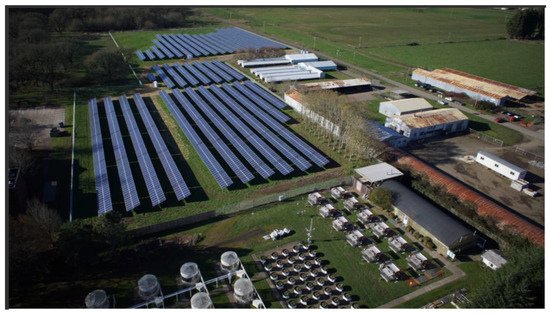As more nations move towards net-zero emission goals by 2050, research into the coupling of photovoltaics (PV) and agriculture has increased into a new sector of agrivoltaics (AV). Measurement of the Land Equivalent Ratio (LER) has allowed researchers to develop methods for optimizing the agrivoltaic system. While AVs are seen as a method to reduce the land loss for traditional PV farms, research has shown that they can be both beneficial to crop growth and PV efficiency. The levels of photosynthetically active radiation (PAR) under the solar modules impact crop species in different ways. Understanding the PAR can be used to determine the most suitable crop to plant for each season. Factors such as micro-climates and water requirements are also changed due to the set-up of each AV system.
- agriculture
- agrivoltaic
- photovoltaic
- renewable energy
- land-use
1. Land Use Optimization


2. Mutually Beneficial Relationship
The optimization of an AV system requires an understanding of both the crops PAR, which is considered to be the entire visible light spectrum (400–700 nm) [15][21], and PV efficiency. Earlier studies analyzed the impacts of shading on crop yields (lettuce) [16][22] and the benefits of micro-climates created by under-panel crops [17][23]. These initial studies were limited in the variety of crop types and locations. However, with the growing need to move towards dual-land use options, numerous experimental and modeled studies were conducted in this region of interest. A substantial amount of current research revolves around identifying crops that would benefit from growing in an AV system. The determination of AV-compatible crops is vital to the success of a coupled system. Studies such as those conducted by [18][19][24,25] analyzed the irradiation under the PV modules and the overall effects on crop yields. Along with in situ experiments, researchers made use of simulation software for both PV electricity generation (PVSYST) and for crop modeling (STICS) to run optimization studies [3][9]. AThis review provides a comprehensive list of crops that were studied recently (post-2016) and how the shading from an AV system impacts crop yield is provided.3. Crop Production
As installations of AV systems have increased in the last five years, the field of research has expanded into determining crops that are best suited for the coupled system. HeThis rein, 23 studies wereview covered and it was 23 studies that focused on the impact of PVs on the growth of different crops. The most common plants studied were lettuce, tomatoes, and wheat, covering four different countries and three states. The different studies were designed to make observations on different aspects of the AV systems. Figure 17 shows the set-up for a study on lettuce growth under two types of AV arrangements [18][24]. Some studies, such as those conducted by [20][49], investigated the relationship to crop production to the profitably of the AV farm, while other studies, such as the one conducted by [21][50], focused on crop yield. Table 3 reviews the different studies and notable observations.Non-Commercial Crops
The studies reviewed also considered the use of AV for grazing grounds for different animals. An in situ study conducted in Oregon, USA, [22][61] determined that despite a reduction in herbage (38%), the AV produced higher quality; thus, spring lamb growth was not affected. In a modeled study regarding rabbits, Ref. [23][62] described how AV could also be used as a protective fence against predators while allowing the rabbits to graze on the grass under the panel, which has the potential to increase the revenue of a PV farm. The conclusion was reached by a reduction in operation and maintenance costs associated with grass mowing. Another new area of research for non-commercial crops is based on what is referred to as pollinators. Ref. [24][63] investigated the impact the solar canopy had on the bloom time of habitats for pollinating insects. They showed that the AV system increased the floral yield and delayed bloom time, which can help late-season pollinators.4. Micro-Climates
The effects of a PV on the shaded area underneath tend to create a micro-climate. These micro-climates generally have lower soil and crop temperatures [17][23] and impact water requirements and PV efficiency. The panel layout, as discussed in Section 2.2.1, also impacts the micro-climate. Ref. [25][64] evaluated a Python model using a checkerboard panel placement. The method was not able to increase soil temperatures enough to prevent frost.4.1. Water Usage
Several studies were conducted on the micro-climate that is created under AV systems. As indicated[21] in Table 3, [50] monitored both crop yield but also water efficiency. The transpiration rate is slower under the PV due to the shading. This both lowers the soil temperature [26][35] and increases soil moisture [21][50], leading to a reduction in water usage. It was concluded by both [21][27][50,65] that hot arid climates would benefit from the creation of these AV micro-climates. The study by [28][52] saw a reduction in crop yield but also observed an increase in irrigation savings for all crops ranging from 9 to 14% savings. Another study in Oregon by [29][34] found a staggering 328% increase in water efficiency at their Rabbit Hills site (Figure 28) for areas observed under the AV system. This savings in water is yet another benefit that farmers would gain with an AV system.

